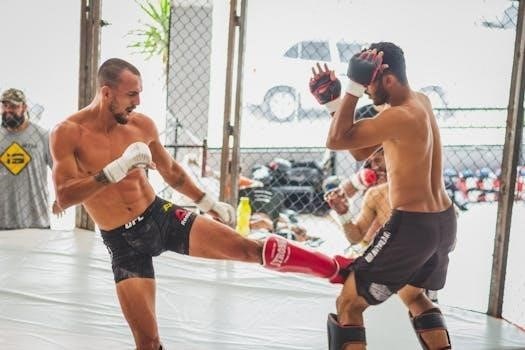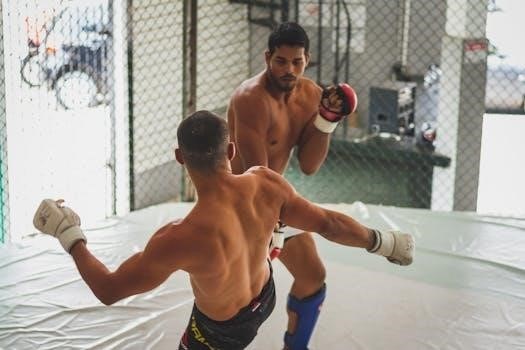While technique is paramount in Brazilian Jiu-Jitsu, physical conditioning plays a vital role. A well-designed strength program supplements mat work, ensuring your body can execute techniques effectively. This enhances overall performance and reduces the risk of injuries. Integrating strength training is key for BJJ success.
The Importance of Strength and Conditioning for BJJ
In Brazilian Jiu-Jitsu, strength and conditioning are not just beneficial; they are crucial for optimal performance and longevity. While technique remains the cornerstone, physical prowess allows practitioners to apply their skills more effectively against resisting opponents. Strength training helps in generating power for takedowns, escapes, and submissions, while also improving grip strength for maintaining control. Furthermore, a robust conditioning program enhances endurance, enabling athletes to sustain high-intensity grappling sessions without succumbing to fatigue. This is particularly crucial as BJJ matches often require prolonged exertion. Injury prevention is another key benefit; strong muscles, tendons, and ligaments offer better protection against strains and sprains. Ultimately, strength and conditioning is an integral part of the puzzle for any serious BJJ practitioner.

Designing a BJJ Strength Training Program
Creating an effective BJJ strength program involves careful planning. Balancing mat training with lifting is key. Focus on movements that enhance grappling performance, not just general strength.
Frequency of Strength Training Sessions
The ideal frequency of strength training sessions for BJJ practitioners depends largely on individual factors such as training experience, recovery capacity, and proximity to competition. Generally, lifting 2-3 times per week is suitable when you are not preparing for a tournament. As a competition nears, this may decrease to 1-2 times per week to prioritize recovery and prevent overtraining. Consistency is paramount; however, it is important to listen to your body. Ensure adequate rest between training sessions to allow muscles to repair and adapt. A structured approach to frequency will maximize strength gains while avoiding burnout and minimizing the risk of injury. Balancing your time on the mats with time in the gym is crucial for optimal performance. Proper planning is essential for progress.
Balancing BJJ Training and Strength Work
Finding the right balance between technical BJJ training and strength work is crucial for optimal progress. BJJ itself is excellent cardio, so a well-structured lifting program can enhance your physique and performance. The key is to avoid overtraining, which can hinder both your BJJ and your strength gains. Strength training should complement your BJJ, not detract from it. Prioritize recovery, ensuring you have enough rest between sessions of each type of training. It’s often best to avoid intense strength training on days you have hard BJJ training. Listen to your body and adjust your training schedule based on how you feel. A balanced approach will help you excel in both areas. A strategic training plan is essential for success.
Key Principles of Strength Training for BJJ
Strength training for BJJ should focus on building functional strength and power, not just overall muscle mass. Prioritize compound movements like squats, deadlifts, and presses, which engage multiple muscle groups. Keep reps in the 2-6 range to build strength without excessive size. Incorporate exercises that improve spinal stability and core strength. Remember, you’re training to enhance your BJJ performance, not to become a powerlifter. Focus on controlled movements and proper form to prevent injuries. Include exercises that improve grip strength, such as dead hangs. Remember to emphasize movements that translate to the mat, rather than isolation exercises. Consistency and proper recovery are crucial for optimal results. Prioritize strength and power development over hypertrophy. Your goal is to get stronger for BJJ, not just to get bigger.

Sample BJJ Strength Training Program
This section provides a structured workout plan to enhance BJJ performance. It includes exercises focused on strength, power, and core stability. A sample warm-up routine is also included.
Workout Structure for BJJ
A well-structured BJJ strength training program should prioritize movements that complement the demands of grappling. Each workout should begin with a dynamic warm-up to elevate heart rate, raise core temperature and improve blood flow to the limbs. Focus on compound exercises that engage multiple muscle groups to maximize efficiency. These include variations of deadlifts, squats, and pressing movements. Incorporate both vertical and horizontal pushing exercises for balanced upper body strength. It’s essential to keep the rep range between 2-6 for strength gains without adding excessive size. Remember, you are training for BJJ performance and not to become a powerlifter. Prioritize proper form and avoid excessive training volume that may hinder recovery. Each workout should bring you closer to your BJJ strength and performance goals. Ensure sufficient rest between sets to maximize strength output.
Exercises for Strength and Power
For BJJ, prioritize exercises that build functional strength and explosive power. Deadlifts, in various forms, are foundational for developing overall strength and core stability, essential for grappling. Squat variations, such as front squats and goblet squats, build lower body power. Incorporate pushing exercises like bench presses and overhead presses, focusing on proper form. Pulling movements, such as rows and pull-ups, are vital for back strength and grip. Include explosive exercises like kettlebell swings and plyometrics to improve power output. Remember, each exercise should translate to improved performance on the mats. Focus on controlled movements to prevent injuries and ensure proper muscle engagement. Keep the rep range low, usually between 2-6, to build strength, not just size. These exercises are essential to improve your strength for BJJ.
Sample Warm-up Routines
A proper warm-up is crucial before any BJJ strength training session. Begin with light cardio, such as jogging or jumping jacks, to elevate your heart rate and increase blood flow; Follow this with dynamic stretches, focusing on movements that mimic BJJ actions. Include arm circles, leg swings, and torso twists. Core activation exercises, such as planks and bird dogs, are important for stability. Hip mobility drills, like hip circles and leg cradles, improve flexibility for grappling movements. A brief series of bodyweight squats and push-ups will further prepare your muscles. The goal is to increase body temperature, enhance joint mobility, and activate the muscles you will use in your workout. This routine should last between 5-10 minutes, preparing your body for the workout. Incorporate these before each training session to maximize your performance.

Specific Considerations for BJJ
BJJ demands unique physical attributes. Grip strength, core stability, and injury prevention are key focus areas. Targeted exercises address these specific needs, enhancing performance and longevity on the mats.
Grip Strength Training
Grip strength is paramount in BJJ, crucial for controlling opponents and executing techniques effectively. Training should focus on both crushing and support grip. Exercises like dead hangs, towel pull-ups, and gi pull-ups are highly beneficial. Incorporate farmer’s walks, and wrist curls to build forearm strength. Remember, a strong grip isn’t just about raw power; it’s also about endurance. Vary your training to include both static holds and dynamic movements. Kettlebells and thick bar training can be valuable tools for enhancing grip strength. Always prioritize proper form to prevent injuries. Consider using grip strengtheners and specialized tools, but also ensure to train your grip in a way that mimics the demands of BJJ, like gripping a gi. Consistency and progressive overload are key to building a truly powerful and resilient grip. Integrating grip training into your routine will undoubtedly improve your performance on the mat.
Core Strength and Stability
Core strength and stability are fundamental for BJJ practitioners. A strong core enables efficient power transfer, improves balance, and helps prevent injuries. Exercises should target the entire core musculature, including the rectus abdominis, obliques, and transverse abdominis. Planks, dead bugs, and bird dogs are excellent for building stability. Incorporate rotational exercises like Russian twists and cable chops to enhance core power. The McGill stabilization program, emphasizing core bracing, can be highly effective. Avoid excessive flexion movements, which can strain the spine. Focus on controlled movements and proper form. Strengthening your core will significantly improve your ability to generate force on the mat. Stability is key to maintaining positions and preventing sweeps. Remember that core training is not just about six-pack abs but about functional strength. Regularly incorporate core work into your routine to see improvements in your BJJ performance. A stable core is the foundation for all movements.
Injury Prevention Through Strength Training
Strength training is crucial for injury prevention in BJJ. A well-structured program strengthens muscles, tendons, and ligaments, making them more resistant to the stresses of grappling. Focusing on balanced muscle development helps prevent imbalances that can lead to injuries. Strengthening the muscles around the joints, such as the shoulders and knees, provides added support and stability. Incorporate exercises that improve joint mobility and flexibility to further reduce injury risk. Include corrective exercises to address any pre-existing imbalances or weaknesses. Avoid overtraining and allow adequate time for recovery. Proper warm-up routines are also essential to prepare the body for the demands of training; Pay attention to proper form during all exercises to prevent injuries. Strength training should not be excessive and should complement your BJJ training schedule. Consider working with a qualified coach or trainer to develop a program that is safe and effective. A proactive approach to strength training can significantly reduce the likelihood of BJJ-related injuries.

Finding a BJJ Strength Program
Numerous online resources offer BJJ-specific strength programs. Expert guidance from qualified coaches can provide tailored plans. Look for programs that match your experience, goals, and available equipment for optimal results.
Online Resources and Programs
The digital age offers a plethora of online resources for BJJ strength training. Many websites and platforms provide downloadable programs, often in PDF format, catering to various skill levels and training preferences. These resources range from free introductory guides to comprehensive, paid programs designed by experienced strength coaches and BJJ practitioners. Look for reputable sources that emphasize functional movements and prioritize exercises that directly translate to improved performance on the mat. Some programs may include video demonstrations, making it easier to learn proper form. Consider exploring online communities and forums where you can interact with others, share experiences, and gain insights. Remember, the key is to find a program that aligns with your individual needs and training goals, ensuring a balanced approach to both strength and technical BJJ training.
Expert Guidance and Coaching
Seeking expert guidance can significantly enhance your BJJ strength training journey. A qualified coach, especially one with a background in both strength and conditioning and Brazilian Jiu-Jitsu, can provide personalized programming tailored to your specific needs and goals. They can assess your current fitness level, identify areas for improvement, and design a program that addresses your weaknesses while building upon your strengths. Furthermore, a coach can provide valuable feedback on your technique, ensuring you perform exercises safely and effectively. This personalized approach can help you avoid common pitfalls and accelerate your progress. Expert coaching also offers accountability, keeping you motivated and on track. Consider reaching out to certified personal trainers who specialize in BJJ strength or explore training options at BJJ academies that offer integrated strength programs. The investment in expert guidance can be invaluable to maximize your results.
